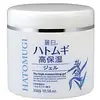What's inside
What's inside
 Key Ingredients
Key Ingredients

No key ingredients
 Benefits
Benefits

 Concerns
Concerns

 Ingredients Side-by-side
Ingredients Side-by-side

Water
Skin ConditioningGlycerin
HumectantButylene Glycol
HumectantDipropylene Glycol
HumectantTriethylhexanoin
MaskingDiphenyl Dimethicone
EmollientPolyglyceryl-10 Myristate
Skin ConditioningPEG-60 Hydrogenated Castor Oil
EmulsifyingCarbomer
Emulsion StabilisingPEG-Crosspolymer
Vigna Radiata Seed Extract
Skin ConditioningIsomerized Safflower Acid
Skin ConditioningSoluble Collagen
HumectantHydrolyzed Collagen
EmollientSuccinic Acid
BufferingDisodium EDTA
Sodium Hydroxide
BufferingCitric Acid
BufferingPhenoxyethanol
PreservativeMethylparaben
PreservativeWater, Glycerin, Butylene Glycol, Dipropylene Glycol, Triethylhexanoin, Diphenyl Dimethicone, Polyglyceryl-10 Myristate, PEG-60 Hydrogenated Castor Oil, Carbomer, PEG-Crosspolymer, Vigna Radiata Seed Extract, Isomerized Safflower Acid, Soluble Collagen, Hydrolyzed Collagen, Succinic Acid, Disodium EDTA, Sodium Hydroxide, Citric Acid, Phenoxyethanol, Methylparaben
Salicylic Acid 1%
MaskingAloe Barbadensis Leaf Juice
Skin ConditioningWater
Skin ConditioningGlycerin
HumectantAlcohol
AntimicrobialVaccinium Myrtillus Fruit Extract
Skin ConditioningXanthan Gum
EmulsifyingSaccharum Officinarum Extract
MoisturisingCitrus Aurantium Bergamia Fruit Oil
MaskingAcer Saccharum Extract
Skin ConditioningAlgae Extract
EmollientCitrus Aurantium Dulcis Fruit Extract
MaskingCitrus Limon Fruit Extract
MaskingFragaria Vesca Fruit Extract
AstringentLactobacillus/Arundinaria Gigantea Ferment Filtrate
Skin ConditioningLeuconostoc/Radish Root Ferment Filtrate
AntimicrobialOlea Europaea Leaf Extract
PerfumingPanax Ginseng Root Extract
EmollientPyrus Malus Fruit Extract
Skin ConditioningRubus Fruticosus Fruit Extract
AstringentSalix Alba Bark Extract
AstringentVitis Vinifera Fruit Extract
Skin ConditioningTocopheryl Acetate
AntioxidantBentonite
AbsorbentCitric Acid
BufferingLactic Acid
BufferingPotassium Hydroxide
BufferingQuartz
AbrasiveSea Silt
Skin ConditioningSodium Phytate
Ethylhexylglycerin
Skin ConditioningPhenoxyethanol
PreservativePotassium Sorbate
PreservativeSodium Benzoate
MaskingBenzyl Alcohol
PerfumingSalicylic Acid 1%, Aloe Barbadensis Leaf Juice, Water, Glycerin, Alcohol, Vaccinium Myrtillus Fruit Extract, Xanthan Gum, Saccharum Officinarum Extract, Citrus Aurantium Bergamia Fruit Oil, Acer Saccharum Extract, Algae Extract, Citrus Aurantium Dulcis Fruit Extract, Citrus Limon Fruit Extract, Fragaria Vesca Fruit Extract, Lactobacillus/Arundinaria Gigantea Ferment Filtrate, Leuconostoc/Radish Root Ferment Filtrate, Olea Europaea Leaf Extract, Panax Ginseng Root Extract, Pyrus Malus Fruit Extract, Rubus Fruticosus Fruit Extract, Salix Alba Bark Extract, Vitis Vinifera Fruit Extract, Tocopheryl Acetate, Bentonite, Citric Acid, Lactic Acid, Potassium Hydroxide, Quartz, Sea Silt, Sodium Phytate, Ethylhexylglycerin, Phenoxyethanol, Potassium Sorbate, Sodium Benzoate, Benzyl Alcohol
Ingredients Explained
These ingredients are found in both products.
Ingredients higher up in an ingredient list are typically present in a larger amount.
Citric Acid is an alpha hydroxy acid (AHA) naturally found in citrus fruits like oranges, lemons, and limes.
Like other AHAs, citric acid can exfoliate skin by breaking down the bonds that hold dead skin cells together. This helps reveal smoother and brighter skin underneath.
However, this exfoliating effect only happens at high concentrations (20%) which can be hard to find in cosmetic products.
Due to this, citric acid is usually included in small amounts as a pH adjuster. This helps keep products slightly more acidic and compatible with skin's natural pH.
In skincare formulas, citric acid can:
While it can provide some skin benefits, research shows lactic acid and glycolic acid are generally more effective and less irritating exfoliants.
Most citric acid used in skincare today is made by fermenting sugars (usually from molasses). This synthetic version is identical to the natural citrus form but easier to stabilize and use in formulations.
Read more about some other popular AHA's here:
Learn more about Citric AcidGlycerin is already naturally found in your skin. It helps moisturize and protect your skin.
A study from 2016 found glycerin to be more effective as a humectant than AHAs and hyaluronic acid.
As a humectant, it helps the skin stay hydrated by pulling moisture to your skin. The low molecular weight of glycerin allows it to pull moisture into the deeper layers of your skin.
Hydrated skin improves your skin barrier; Your skin barrier helps protect against irritants and bacteria.
Glycerin has also been found to have antimicrobial and antiviral properties. Due to these properties, glycerin is often used in wound and burn treatments.
In cosmetics, glycerin is usually derived from plants such as soybean or palm. However, it can also be sourced from animals, such as tallow or animal fat.
This ingredient is organic, colorless, odorless, and non-toxic.
Glycerin is the name for this ingredient in American English. British English uses Glycerol/Glycerine.
Learn more about GlycerinPhenoxyethanol is a preservative that has germicide, antimicrobial, and aromatic properties. Studies show that phenoxyethanol can prevent microbial growth. By itself, it has a scent that is similar to that of a rose.
It's often used in formulations along with Caprylyl Glycol to preserve the shelf life of products.
Water. It's the most common cosmetic ingredient of all. You'll usually see it at the top of ingredient lists, meaning that it makes up the largest part of the product.
So why is it so popular? Water most often acts as a solvent - this means that it helps dissolve other ingredients into the formulation.
You'll also recognize water as that liquid we all need to stay alive. If you see this, drink a glass of water. Stay hydrated!
Learn more about Water